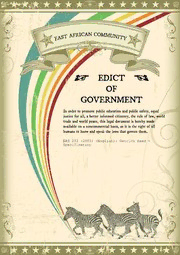
EAS 233: Ostrich feed — Specification PDF
Preview EAS 233: Ostrich feed — Specification
≠ EDICT ± OF GOVERNMENT In order to promote public education and public safety, equal justice for all, a better informed citizenry, the rule of law, world trade and world peace, this legal document is hereby made available on a noncommercial basis, as it is the right of all humans to know and speak the laws that govern them. EAS 233 (2001) (English): Ostrich feed — Specification EAS 233:2001 ICS 65.120 EAST AFRICAN STANDARD Ostrich feed — Specification EAST AFRICAN COMMUNITY © EAC 2001 First Edition 2001 EAS 233:2001 Foreword Development of the East African Standards has been necessitated by the need for harmonizing requirements governing quality of products and services in East Africa. It is envisaged that through harmonized standardization, trade barriers which are encountered when goods and services are exchanged within the Community will be removed. In order to achieve this objective, the Partner States in the Community through their National Bureaux of Standards, have established an East African Standards Committee. The Committee is composed of representatives of the National Standards Bodies in Partner States, together with the representatives from the private sectors and consumer organizations. Draft East African Standards are circulated to stakeholders through the National Standards Bodies in the Partner States. The comments received are discussed and incorporated before finalization of standards, in accordance with the procedures of the Community. East African Standards are subject to review, to keep pace with technological advances. Users of the East African Standards are therefore expected to ensure that they always have the latest versions of the standards they are implementing. © East African Community 2001 — All rights reserved* East African Community P O Box 1096 Arusha Tanzania Tel: 255 27 2504253/8 Fax: 255-27-2504481/2504255 E-Mail: [email protected] Web: www.each.org * © 2001 EAC — All rights of exploitation in any form and by any means reserved worldwide for EAC Partner States’ NSBs. ii © EAC 2001 — All rights reserved EAST AFRICAN STANDARD EAS 233:2001 Ostrich feed — Specification 1 Scope This East African Standard specifies the requirements and test methods for ostrich feed. 2 Definitions For the purposes of this East African Standard, the following definitions shall apply: 2.1 pre-starter: 0 - 2 weeks 2.1.1 starter: 2 weeks- 2 months 2.1.2 grower: 2 months- 5 months 2.1.3 finisher: 5 months- 12 months 2.1.4 maintenance: 12 months- 24 months 2.1.5 breeder: 24 months and above 2.2 sterilized: Implies that a product has been sterilized in accordance with the East African Community Health Regulations. 3 Compositional and quality requirements 3.1 Permitted ingredients The material which the product is prepared from, shall be of suitable quality for ostrich consumption. 3.1.1 Essential ingredients a) Vitamins b) Minerals c) Maize meal d) Fish meal e) Lucerne f) Alfalfa/ Lucerne 3.1.2 Optional ingredients Electrolytes pH regulators enzymes 3.2 Prohibitions 3.2.1 Charcoal 3.2.2 Flavouring and colouring material 3.2.3 Non-protein nitrogen ingredients © EAC 2001 — All rights reserved 1 EAS 233:2001 3.3 Feeds additives Permitted feed additives may be used, these may include, a) Sodium chloride b) Anti-oxidants c) Probiotics d) Anti-mycotoxins Their use is limited by Good Manufacturing Practices 3.4 Water Water used in the preparation of the product and in the washing of equipment shall comply with the requirements of relevant East African Standard. 4 Nutrient requirements When tested in accordance with the test methods specified in Table 1, pre- starter, starter, grower, finisher, maintenance and breeder diets shall comply with the requirements given in the same table. Table 1 — Nutrient requirements for ostrich feed Feed Crude Moisture Fibre Calcium Phosphoru Salt M/E protein s Min g/kg Max. g/kg g/kg Min. g/kg Max. g/kg Min. g/kg Min. g/kg MJ/kg Pre-starter 230 120 50 (max) 10 16 7 2 12.5 Starter 220 120 50 (max.) 10 16 6 2 11.5 Grower 190 120 60 (min.) 9 15 5.5 2 10.5 Finisher 140 120 60 (min.) 9 15 5.5 2 9.2 Maintenance 100 120 60 (min.) 8 15 5 2 7.0 Breeder 180 120 60 (min.) 8 15 5 2 4.6 Test EAS 74 EAS 74 EAS 74 EAS 74 EAS 74 EAS 74 EAS 74 ISO 9831 methods 5 Upper limits of toxins and anti-nutritional factors When tested in accordance with the test methods specified in Table 2, the upper limits of toxins and anti-nutritional factors in ostrich feeds shall be as specified in the same table. Table 2 — Upper limit of toxins and anti-nutritional factors Toxins and anti- Class diets nutritional factors Pre-starter Starter Grower Finisher Maintenance Breeder Test (max. limits) methods Mycotoxins mg/ kg 5 10 20 20 20 10 EAS 74 Free Gossypol mg/kg 50 50 50 120 15 120 ISO 6866 Trypsin inhibitor (Measured in urease 5 5 5 5 5 5 ISO 5506 activity)% 6 Sampling and preparation of test samples Methods of sampling animal feeding stuffs and the preparation of test samples, shall be in accordance with EAS 74-2. 7 Containers Ostrich feeds shall be packed in containers, which are, sound and clean and which shall be able to protect the feed from contamination. 2 © EAC 2001 — All rights reserved EAS 233:2001 8 Labelling Every container of ostrich feed purporting to comply with this East African Standard, shall be labelled in accordance with EAS 38, Labelling of prepackaged foods and shall bear the following information, which shall be printed either on the container or on the label attached thereto. a) name of the product; b) name and physical address of the manufacturer; c) expiry dates; d) batch number; e) date of manufacture and f) a description of the type of ostrich feed and an indication of the class of ostrich to which it is to be fed. © EAC 2001 — All rights reserved 3
